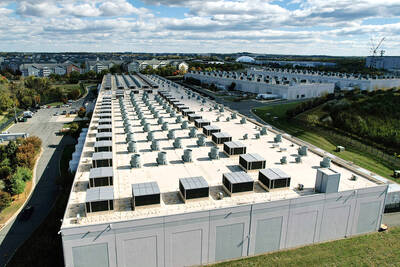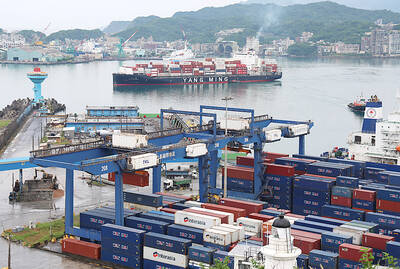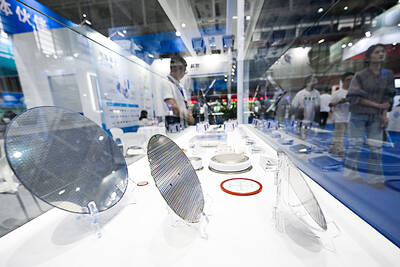Apple Inc is expected to crank out a small volume of next-generation Micro-LED displays from a plant in Taoyuan by the end of this year for its wearable devices, an IDC analyst said yesterday.
The US technology giant is forecast to begin mass production of Micro-LED displays at the plant in Longtan District (龍潭) next year, ahead of rival display makers, IDC analyst Annabelle Hsu (徐美雯) said.
Apple might initially use the brighter, more energy efficient and foldable Micro-LED displays on new Apple Watches, Hsu said.
The company has kept a low profile about the Longtan display factory since it began operations two years ago. The Hsinchu Science Park Bureau in 2015 confirmed the presence of the Apple plant, without elaborating.
Apple has placed more focus on Micro-LED technology after acquiring LuxVue Technology Corp in 2014.
The newest self-emitting display technology shares traits with expensive organic LED (OLED) technology, but costs less.
“Many display makers consider Micro-LED technology a panacea for making flexible displays due to lower technological barriers, compared with OLED technology,” Hsu said. “Flexible display technologies are seen as the possible driving force to developments in end products in the next decade.”
However, Hsu does not expect Micro-LED technology to become commercially available before 2020.
Innolux Corp (群創), a Hon Hai Group (鴻海集團) flat-panel manufacturing subsidiary, has allocated resources to explore Micro-LED technology, but has not yet released any details.
Samsung Electronics Co is the only company in the world capable of supplying OLED panels for mobile phones at present, while LG Display Inc and AU Optronics Corp (友達光電) are mostly making smaller-sized OLED displays used in wearable devices, Hsu said.
APPLE PAY CONCERNS
In other news, the launch on Wednesday of Apple Pay in Taiwan has raised concerns about the possibility of declining credit card fee income for local banks, the Chinese-language Economic Daily News reported yesterday, citing an industry insider.
The newspaper said Apple would soon be joining issuing banks and network operators such as Visa Inc and MasterCard Inc in taking a slice of the profits from transaction fees.
“Apple Pay operates in existing transaction markets wherever credit cards are accepted; it is not a new segment and it does not make the pie bigger for issuer banks,” the newspaper quoted a bank manager, who wished to remain unidentified, as saying.
Apple Pay is not expected to catalyze significant growth in the local market for credit card transactions, but the new service would take its 0.0015 percent cut of transactions made with the mobile wallet, the manager said.
Compared with conventional credit cards, banks collect lower fees when purchases are made with Apple Pay, and fee income would decline more rapidly if the mobile wallet gains popularity, the manager said.
Market observers have said that the payment service, which is only available for Apple’s newer smartphones, trails behind that of the rival Android operating system.
Samsung, an Android smartphone maker, commands 24.6 percent of Taiwan’s smartphone market, compared with Apple’s 18.7 percent, market statistics showed.
Cathay United Bank (國泰世華銀行), the nation’s leading credit card issuer with 4.2 million active cards as of the end of last month and NT$392.9 billion (US$12.96 billion) total transactions last year, reported that credit card had contributed NT$5.7 billion out of the NT$18.4 billion in overall fee income that the bank earned last year.

The demise of the coal industry left the US’ Appalachian region in tatters, with lost jobs, spoiled water and countless kilometers of abandoned underground mines. Now entrepreneurs are eyeing the rural region with ambitious visions to rebuild its economy by converting old mines into solar power systems and data centers that could help fuel the increasing power demands of the artificial intelligence (AI) boom. One such project is underway by a non-profit team calling itself Energy DELTA (Discovery, Education, Learning and Technology Accelerator) Lab, which is looking to develop energy sources on about 26,305 hectares of old coal land in

Taiwan’s exports soared 56 percent year-on-year to an all-time high of US$64.05 billion last month, propelled by surging global demand for artificial intelligence (AI), high-performance computing and cloud service infrastructure, the Ministry of Finance said yesterday. Department of Statistics Director-General Beatrice Tsai (蔡美娜) called the figure an unexpected upside surprise, citing a wave of technology orders from overseas customers alongside the usual year-end shopping season for technology products. Growth is likely to remain strong this month, she said, projecting a 40 percent to 45 percent expansion on an annual basis. The outperformance could prompt the Directorate-General of Budget, Accounting and

Netflix on Friday faced fierce criticism over its blockbuster deal to acquire Warner Bros Discovery. The streaming giant is already viewed as a pariah in some Hollywood circles, largely due to its reluctance to release content in theaters and its disruption of traditional industry practices. As Netflix emerged as the likely winning bidder for Warner Bros — the studio behind Casablanca, the Harry Potter movies and Friends — Hollywood’s elite launched an aggressive campaign against the acquisition. Titanic director James Cameron called the buyout a “disaster,” while a group of prominent producers are lobbying US Congress to oppose the deal,

Two Chinese chipmakers are attracting strong retail investor demand, buoyed by industry peer Moore Threads Technology Co’s (摩爾線程) stellar debut. The retail portion of MetaX Integrated Circuits (Shanghai) Co’s (上海沐曦) upcoming initial public offering (IPO) was 2,986 times oversubscribed on Friday, according to a filing. Meanwhile, Beijing Onmicro Electronics Co (北京昂瑞微), which makes radio frequency chips, was 2,899 times oversubscribed on Friday, its filing showed. The bids coincided with Moore Threads’ trading debut, which surged 425 percent on Friday after raising 8 billion yuan (US$1.13 billion) on bets that the company could emerge as a viable local competitor to Nvidia